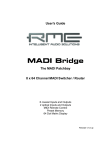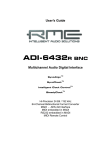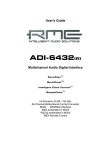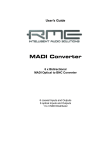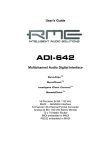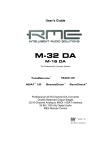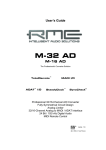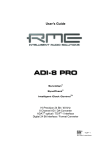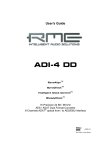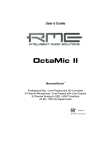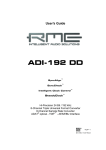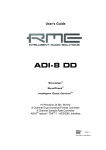Download Rancent Tech RG59 User`s guide
Transcript
User's Guide ADI-648 Multichannel Audio Digital Interface SyncAlign TM TM SyncCheck Intelligent Clock Control TM TM SteadyClock Hi-Precision 24 Bit / 192 kHz 64 Channel MADI / ADAT Converter 16 x 16 Matrix Router MIDI embedded in MADI MADI 24 Bit Interface Firmware 2.5 Important Safety Instructions ...........................................................................3 1 2 3 4 Introduction ........................................................................................................5 Package Contents ..............................................................................................5 Brief Description and Characteristics..............................................................5 Technical Specifications 4.1 Inputs...............................................................................................................6 4.2 Outputs............................................................................................................7 5 First Usage 5.1 Quick Start ......................................................................................................8 5.2 Firmware .........................................................................................................8 5.3 Operating the ADI-648 ....................................................................................9 6 The MADI to ADAT Converter 6.1 General .........................................................................................................10 6.2 Inputs.............................................................................................................10 6.3 Input State Display ........................................................................................10 6.4 Outputs ADAT Optical...................................................................................11 7 The ADAT to MADI Converter 7.1 General .........................................................................................................12 7.2 Inputs.............................................................................................................12 7.3 Input State Display ........................................................................................12 7.4 Outputs MADI................................................................................................13 8 Clock Section 8.1 Clock Configuration.......................................................................................13 8.2 Lock and SyncCheck ....................................................................................14 8.3 Word Clock Input and Output........................................................................15 9 Word Clock 9.1 Operation and Technical Background ..........................................................16 9.2 Cabling and Termination...............................................................................17 10 MIDI 10.1 Transmission of MIDI..................................................................................18 10.2 Remote Controlling the ADI-648 ................................................................18 10.3 Remote Control Software ...........................................................................19 11 Special Modes 11.1 MADI to MADI Converter............................................................................21 11.2 ADAT Patchbay and Splitter.......................................................................21 11.3 MADI Coaxial/Optical Converter ................................................................21 11.4 MADI Merger ..............................................................................................22 11.5 MADInet......................................................................................................22 12 Technical Background 12.1 DS – Double Speed....................................................................................23 12.2 QS – Quad Speed ......................................................................................23 12.3 MADI Basics ...............................................................................................24 12.4 SteadyClock ...............................................................................................25 13 Controls and Connectors ................................................................................26 14 Block Diagram ..................................................................................................27 15 MIDI Implementation Chart 15.1 Basic SysEx Format ...................................................................................28 15.2 Message Types ..........................................................................................28 15.3 MADI Input State – Redundancy Mode......................................................28 16 Warranty............................................................................................................31 17 Appendix ...........................................................................................................31 2 User's Guide ADI-648 © RME Important Safety Instructions ATTENTION! Do not open chassis – risk of electric shock The unit has non-isolated live parts inside. No user serviceable parts inside. Refer service to qualified service personnel. Mains • The device must be earthed – never use it without proper grounding • Do not use defective power cords • Operation of the device is limited to the manual • Use same type of fuse only To reduce the risk of fire or electric shock do not expose this device to rain or moisture. Prevent moisture and water from entering the device. Never leave a pot with liquid on top of the device. Do not use this product near water, i. e. swimming pool, bathtub or wet basement. Danger of condensation inside – don't turn on before the device has reached room temperature. Installation Surface may become hot during operation – ensure sufficient ventilation. Avoid direct sun light and do not place it near other sources of heat, like radiators or stoves. When mounting in a rack, leave some space between this device and others for ventilation. Unauthorized servicing/repair voids warranty. Only use accessories specified by the manufacturer. Read the manual completely. It includes all information necessary to use and operate this device. User's Guide ADI-648 © RME 3 4 User's Guide ADI-648 © RME 1. Introduction With the ADI-648 you have an incredibly versatile digital interface to your supply. What at first looks like a simple MADI to ADAT format converter, turns out to be an extremely flexible problem solver at a closer look. From small project studios to broadcast and television, this Advanced Digital Interface is the perfect tool for many tasks. As a consequent continuation of RME's world-wide successful ADI-8 series, the 648 also contains elaborate technology and the latest integrated circuits. In a few words: The ADI-648 is a uniquely powerful and high-quality device, which will excite you even after many years of operation. 2. Package Contents Please check that your ADI-648 package contains each of the following: • ADI-648 • Manual • Power cord 3. Brief Description and Characteristics The ADI-648 consists of two 64-channel digital format converters in reference quality, in a standard 19" box with 1 unit height. The compact device has numerous extraordinary features like Intelligent Clock Control (ICC), SyncCheck®, SyncAlign®, Bitclock PLL, SteadyClock, patchbay functionality, and a 16x16 Matrix router. All of the ADI-648 I/Os support 192 kHz/24 bit. As ADAT optical is restricted to 48kHz, in DS mode (Double Speed) two channels are being used for the transmission of one channel's data. The Sample Split algorithm used is compatible to S/MUX and Double Wire, and also implemented in RME's Hammerfall DSP and FireWire devices. Thus the ADI-648 also serves as an ideal MADI frontend for these interfaces, on both Mac and PC. The format conversion between MADI and ADAT operates in both directions at the same time. LEDs of different colours show the present state of incoming and outgoing signals and of the internal processing in a clear way. The unique Intelligent Clock Control (ICC) allows for a flexible use with internal clock (44.1, 48, 88.2 and 96 kHz), external word clock or the digital input signals. These options are intelligently coupled in a way typical for RME, and easy to apply thanks to a clear and easily understandable display of the Lock and Sync states. Futhermore the unique 16 x 16 Matrix Router allows to use the ADI-648 as patchbay and splitter. All 128 input channels, MADI and ADAT, can be routed to all 128 outputs – even within the same format. User's Guide ADI-648 © RME 5 4. Technical Specifications • • • • • • • Power supply: Internal switching PSU, 100 - 240 V AC, 20 Watt Typical power consumption: 9 Watt Dimensions including rack ears (WxHxD): 483 x 44 x 242 mm (19" x 1.73" x 9.5") Dimensions without rack ears/handles (WxHxD): 436 x 44 x 235 mm (17.2" x 1.73" x 9.3") Weight: 2 kg ( 4.4 lbs) Temperature range: +5° up to +50° Celsius (41° F up to 122°F) Relative humidity: < 75%, non condensing 4.1 Inputs MADI • Coaxial via BNC, 75 Ohm, according to AES10-1991 • High-sensitivity input stage (< 0.2 Vpp) • Optical via FDDI duplex SC connector • 62.5/125 and 50/125 compatible • • • • • • Accepts 56 channel and 64 channel mode, and 96k Frame Single Wire: up to 64 channels 24 bit 48 kHz Double Wire: up to 32 channels 24 bit 96 kHz Quad Wire: up to 16 channels 24 bit 192 kHz Lock range: 28 kHz – 54 kHz Jitter when synced to input signal: < 1 ns ADAT Optical • 8 x TOSLINK, according to Alesis specification • Standard: 64 channels 24 bit, up to 48 kHz • S/MUX: 8 x 4 channels 24 bit / 96 kHz • S/MUX4: 8 x 2 channels 24 bit / 192 kHz • Bitclock PLL ensures perfect synchronisation even in varispeed operation • Lock range: 31 kHz – 56 kHz • Jitter when synced to input signal: < 1 ns Word Clock • BNC, not terminated (10 kOhm) • Automatic Double Speed detection and internal conversion to Single Speed • PLL for low jitter synchronisation even in varispeed operation • Transformer coupled, galvanically isolated input • Not affected by DC-offsets within the network • Signal Adaptation Circuit: signal refresh through auto-center and hysteresis • Overvoltage protection • Level range: 1.0 Vpp – 5.6 Vpp • Lock range: 27 kHz – 112 kHz • Jitter when synced to input signal: < 1 ns • Switch for internal termination 75 Ohm 6 User's Guide ADI-648 © RME MIDI • 16 channels MIDI • 5-pin DIN jack • Optocoupled, ground-free input • Invisible transmission via User bit of channel 56 (up to 48 kHz) • Invisible transmission via User bit of channel 28 (96k Frame) 4.2 Outputs MADI • Coaxial via BNC, 75 Ohm, according to AES10-1991 • Output voltage 600 mVpp • Cable length: up to 100 m • Optical via FDDI duplex SC connector • 62.5/125 and 50/125 compatible • Cable length: up to 2,000 m • • • • Generates 56 channel and 64 channel mode, and 96k Frame Single Wire: up to 64 channels 24 bit 48 kHz Double Wire / 96K Frame: up to 32 channels 24 bit 96 kHz Quad Wire: up to 16 channels 24 bit 192 kHz ADAT Optical • 8 x TOSLINK • Standard: 8 x 8 channels 24 bit, up to 48 kHz • S/MUX: 8 x 4 channels 24 bit / 96 kHz • S/MUX4: 8 x 2 channels 24 bit / 192 kHz Word Clock • BNC • Max. output voltage: 5 Vpp • Output voltage @ 75 Ohm: 4.0 Vpp • Impedance: 10 Ohms • Frequency range: 27 kHz – 56 kHz MIDI • 16 channels MIDI • 5-pin DIN jack 4.2 Digital • • • • • • • Clocks: Internal, ADAT In, MADI In, Word Clock In Low jitter design: < 1 ns in PLL mode, all inputs Internal clock: 800 ps jitter, random spread spectrum Jitter suppression of external clocks: > 30 dB (2.4 kHz) PLL ensures zero dropout, even at more than 100 ns jitter Additional Bitclock PLL for trouble-free varispeed ADAT operation Supported sample rates: 32 / 44.1 / 48 / 64 / 88.2 / 96 / 176.4 / 192 kHz User's Guide ADI-648 © RME 7 5. First Usage 5.1 Quick Start The user interface of the ADI-648 is characterized by a clearly structured architecture and an unambiguous labelling of the front and rear sides. The device can thus be used easily without a manual, because numerous LEDs show the state of the device and of all incoming and outgoing signals in a strictly logical way. However, we don't want to hold you back from reading this manual, as it includes a lot of important and useful information. The ADI-648 remembers all settings before switching off and sets them automatically when switching on the next time. When being switched on for the first time, the ADI-648 comes up in a default mode, which should be appropriate for most applications. The device is in slave mode and gets its reference clock directly out of the MADI input signal. The Matrix Router is deactivated. A quick guide for operation and functionality of the ADI-648 can be found on the next page. For transmission of the digital signals into a computer we recommend RME's interface cards of the Hammerfall® DSP series, especially the HDSP MADI. These high quality digital audio cards are available with drivers for all common operating systems, and have the highest reputation world-wide. 5.2 Firmware The ADI-648's main part has been realized using programmable logic. By exchanging a little component called EPROM, both function and behaviour of the unit can be changed at any time. At the time of writing this manual, the unit is shipped with firmware 2.5. This firmware is not compatible to older units, which do not have the REMOTE key. The firmware version is displayed after power on by the AUDIO LEDs for about one second. Since firmware version 2.5 not only ADAT input 8, but also the current Matrix configuration influences the output mode. If MADI output group 8 is assigned to any input, the device generates 64 channel format. This is also true when MATRIX STATE is set to OFF. As this channel assignment is factory default, all ADI-648 with firmware 2.5 will generate 64 channel mode as default mode. To activate the 56 channel format for the MADI output, the MADI output group 8 has to be set to Mute, and no signal must be present at ADAT input 8. 8 User's Guide ADI-648 © RME 5.3 Operating the ADI-648 Join us for a small 'tour de ADI', starting on the left side at the MADI to ADAT Converter. Configuration starts with choosing the input, BNC or optical. The state of the input signal is displayed by 14 LEDs. Shown are active input, automatic input selection, receiver state, Sync, 56 or 64 channel format, 48k Frame or 96k Frame, and audio data within 8-channel groups. The Sync LED shows the synchronicity between input signal and external/internal clock, or between the active inputs. The ADAT to MADI Converter shows the Sync state for each of the 8 inputs via 8 LEDs. Again 8 LEDs display incoming audio data per 8channel group. By using the 96k FRAME key, the MADI output is switched into Double Speed mode. This mode is active when the '96k Frame' LED is lit. In case the WCK LED is lit, the word clock output no longer provides 44.1/48 kHz, but 88.2/96 kHz. However many devices operate in Single Speed only, and distribute – as known from Double Wire – 96 kHz data on two channels. In this case the ADI-648 operates correctly even without changing to 96k Frame mode, because Double Wire will be converted 1:1 to ADAT (S/MUX). RME's intelligent clock control (ICC) offers extensive and professional means. To start with, the clock source can be set to Internal (crystal), External (BNC word clock) and Input, while Input lets you select between ADAT and MADI. The INT(ernal) clock rates are 44.1 and 48kHz. Lock state is displayed by the state of the input LEDs (flashing or constantly lit). The ADI-648 can be remote controlled by MIDI commands. The key REMOTE is used to select the source of the MIDI commands, and also the destination for the ADI-648's request replies. The normal MIDI ports or the MADI input and output can be chosen. The current REMOTE selection does not have any influence on the basic conversion of MIDI to MADI and vice versa. Normally all 64 MADI channels will be routed to the according ADAT outputs, and all ADAT inputs to the 64-channel MADI output (optical and coaxial output operate in parallel). The 16 x 16 Matrix Router can be activated via the STATE key, and allows to change this routing. First choose an output by pressing the Output Select key, then use the Input Select key to select the desired input. An input can be assigned to as many outputs as present (splitting), but an output can not be assigned to more than one input (digital mixing). Routing within the same format is also allowed. This way ADAT inputs can be routed directly to ADAT outputs, without the need of a MADI loopback cabling. So all attached devices can send signals to each other without the need to rearrange the cabling between them. When stepping through all inputs: the input is muted when no LED is lit. To reset the Matrix Router to the factory default (routing as if de-activated), press the INPUT and OUTPUT SELECT keys at the same time. User's Guide ADI-648 © RME 9 6. The MADI to ADAT Converter 6.1 General This part of the ADI-648 converts MADI to ADAT optical. MADI offers 64 channels of 24 bit audio at up to 48 kHz sample rate, 32 channels at up to 96 kHz, or 16 channels at up to 192 kHz. Transmission happens over a single line, either coaxial (BNC) or fiber optic (network). In both cases the cable length can be more than 100 meters. The 64 MADI channels are transferred to 8 ADAT optical outputs (TOSLINK). Furthermore, the ADI-648 contains an easy-configurable 8-channel 16x16 Matrix Router. Any of the outputs, which are divided into 8-channel blocks, can be fed from any 8-channel input block, both on the ADAT and the MADI side. With this, there is not only free routing within the MADI to ADAT conversion, but also splitting and routing within the same format. 6.2 Inputs Both MADI inputs are located on the rear of the ADI-648. The BNC input's ground-free design is built according to AES10-1991. The input's impedance is 75 Ohm. It will operate error-free from about 180 mVpp. The optical input uses a FDDI (ISO/IEC 9413-3) compatible optical module, according to AES10-1991. More information can be found in chapter 12.2, MADI Basics. The ADI-648 includes automatic input selection. In case the current input signal fails, the unit switches to the other input immediately. This mode, called redundancy mode, offers improved safety against errors on the transmission line. Switching the inputs is done in about one second. The ADI-648 displays redundancy operation by a blinking LED of the original input, while the input LED of the currently active input will be lit constantly. 6.3 Input State Display The state of the MADI input is displayed by different LEDs. The ERROR LED is directly coupled with the MADI-Receiver, and informs the user reliably about the quality of the input signal. The LED will light up red, as soon as there is any error, be it a carrier voltage which is too low, invalid data or any other error which prevents the receiver from accepting the input signal. If a valid input signal is applied, SyncCheck is active automatically. If the MADI input is not chosen as clock source, SyncCheck takes the chosen clock (Internal, External, ADAT) as reference and compares it with the MADI input clock. In case no synchronous operation is detected the SYNC LED will start blinking. Audio data present in the input channels is signalled by an AUDIO LED. As the ADI-648 is based on ADAT ports and therefore operates in 8-channel blocks, an AUDIO LED will show audio data from 8 channels simultaneously. The green LED is lit as soon as one of the channels of an 8-channel block contains audio data, means is no longer digital zero. 10 User's Guide ADI-648 © RME 6.4 Outputs ADAT Optical The ADI-648 provides 8 outputs in ADAT optical format. They are fully compatible to all ADAT optical inputs. A usual TOSLINK cable is sufficient for connection. With the Matrix Router de-activated, all MADI channels are copied to the 8-channel ADAT format in a logical order: MADI In ADAT Out 1-8 1 9-16 2 17-24 3 25-32 4 33-40 5 41-48 6 49-56 7 57-64 8 If a MADI signal in Double Wire format (standard frame) is present at the input, technically no special processing is activated, because the output signals will be in Sample Split format (S/MUX) right away. In 96K FRAME mode, the ADI-648 automatically converts Double Speed data to Sample Split (S/MUX). The data of one MADI channel will be processed and routed to two ADAT channels according to the following table: MADI In DS Signal Port 1 1/2 1 2 3/4 1 3 5/6 1 4 7/8 1 5 1/2 2 6 3/4 2 7 5/6 2 8 7/8 2 MADI In DS Signal Port 9 1/2 3 10 3/4 3 11 5/6 3 12 7/8 3 13 1/2 4 14 3/4 4 15 5/6 4 16 7/8 4 MADI In DS Signal Port 17 1/2 5 18 3/4 5 19 5/6 5 20 7/8 5 21 1/2 6 22 3/4 6 23 5/6 6 24 7/8 6 MADI In DS Signal Port 25 1/2 7 26 3/4 7 27 5/6 7 28 7/8 7 29 1/2 8 30 3/4 8 31 5/6 8 32 7/8 8 As the device internally always operates in Sample Split mode, the Matrix won't change its functionality in Double Wire, Quad Wire (Sample Split = Single Speed) and 96K Frame (Double Speed). In both cases the number of channels is reduced to 28/32 or 14/16. At the same time the Matrix Router no longer operates in 8-channel, but in 4-channel or 2-channel blocks. User's Guide ADI-648 © RME 11 7. The ADAT to MADI Converter 7.1 General This part of the ADI-648 converts ADAT optical to MADI. ADAT optical carries 8 channels of 24 bit audio at up to 48 kHz sample rate, 4 channels at up to 96 kHz, and 2 channels at up to 192 kHz. Transmission is done via a single optical line (TOSLINK). The length of the optical cable is limited to about 10 m. Because the Sample Split (S/MUX, S/MUX4) format doesn't contain a coding, the ADI-648 cannot distinguish it from normal (44.1/48 kHz) material. Whether the MADI output is supposed to work in 96K Frame mode has to be set explicitly by the user. The inputs can be used in any combination, e. g. it is sufficient to connect an input signal only to input 3. In slave mode, this input is automatically being used as clock source. If more than one signal is present, the one furthest left is being used as clock source, i. e. the active input with the lowest number. The 8 ADAT optical inputs are transferred to a 64-channel MADI output. Furthermore, the ADI648 contains an easy-configurable 8-channel 16x16 Matrix Router. Any of the outputs, which are divided into 8-channel blocks, can be fed from any 8-channel input block, both on the ADAT and the MADI side. With this, there is not only free routing within the ADAT to MADI conversion, but also splitting and routing within the same format. 7.2 Inputs The ADAT optical inputs of the ADI-648 are fully compatible with all ADAT optical outputs. ADAT input 8 is used to switch the MADI output format from 56-channel to 64-channel mode. When ADAT input 8 does not receive a valid input signal, the ADI-648 generates a 56-channel MADI signal. When feeding a valid input signal, a 64-channel MADI signal will be generated. This rule is also true when 96K Frame mode is active. Then 28 or 32 channels will be available. Since firmware version 2.5 the current Matrix configuration also influences the output mode. If MADI output group 8 is assigned to any input, the device generates 64 channel format. This is also true when MATRIX STATE is set to OFF. As this channel assignment is factory default, all ADI-648 will generate 64 channel mode as default mode. To activate the 56 channel format for the MADI output, the MADI output group 8 has to be set to Mute, and no signal must be present at ADAT input 8. 7.3 Input State Display The input state is being displayed by means of 16 LEDs. A missing or invalid input signal is indicated by flashing of the SYNC LED. When using multiple inputs in clock mode ADAT INPUT, the input with the lowest number is being used as clock source. In case ADAT is not chosen as clock reference, SyncCheck takes the chosen clock (internal, external, MADI) as reference and compares it to the clocks of the inputs. Non synchronous inputs will be indicated by flashing of the corresponding SYNC LED. A missing or invalid input signal will be displayed by blinking of the ADAT INPUT CLOCK LED. Audio data present in the input channels are signalled by an AUDIO LED per input. As the ADI648 operates in 8-channel blocks, an AUDIO LED will show audio data from 8 channels simultaneously. The green LED is lit as soon as one of the channels of an 8-channel block contains audio data, means is no longer digital zero. 12 User's Guide ADI-648 © RME 7.4 Outputs MADI At the rear side of the ADI-648 there are two MADI outputs. The BNC output is built according to AES10-1991. The output's impedance is 75 Ohms. The output voltage will be 600 mVpp when terminated with 75 Ohms. The optical output uses a FDDI (ISO/IEC 9413-3) compatible optical module, according to AES10-1991. More information can be found in chapter 11.2, MADI Basics. With the Matrix Router de-activated, all ADAT channels are copied to the MADI format in a logical order: ADAT In MADI Out 1 1-8 2 9-16 3 17-24 4 25-32 5 33-40 6 41-48 7 49-56 8 57-64 When activating the 96k Frame mode, channel distribution changes as follows: ADAT In MADI Out 1 1-4 2 5-8 3 9-12 4 13-16 5 17-20 6 21-24 7 25-28 8 29-32 As the device internally always operates in Sample Split mode, the Matrix won't change its functionality in Double Wire, Quad Wire (Sample Split = Single Speed) and 96K Frame (Double Speed). In both cases the number of channels is reduced to 28/32 or 14/16. At the same time the Matrix Router no longer operates in 8-channel, but in 4-channel or 2-channel blocks. 8. Clock Section 8.1 Clock Configuration The unique ICC technology (Intelligent Clock Control) allows for a flexible use of both converter units with internal clock (44.1 and 48 kHz, 88.2 and 96 kHz in DS mode), external word clock or the digital input signals. All options are intelligently coupled and easily applicable and understandable, thanks to a clear display of the corresponding lock state. As clock source, INTERNAL (crystal), EXTERNAL (BNC word clock) and INPUT (the digital input signal ADAT/MADI) can be chosen. If the clock signal is present, the corresponding LED will light constantly. If no signal is present, the LED will flash. The ADI-648 can extract its reference clock directly from the MADI signal. In most cases an additional word clock will not be necessary. INPUT As displayed on the front panel, the CLOCK SOURCE for the INPUT setting can be the ADAT or MADI input. A missing or invalid clock source signal is indicated by flashing of the corresponding LED. EXT. With EXTERNAL, the ADI-648's word clock input is used as clock reference. The LED will flash, if the word clock is missing or unusable. User's Guide ADI-648 © RME 13 INT. For INTERNAL, 44.1 kHz or 48 kHz sampling rate is available. Note: the key 96k FRAME does only affect the format of the MADI output, not channel distribution or sample rate of the ADAT outputs. For the INTERNAL clock setting it is mandatory that the clock rate of the sources is synchronous to the ADI-648. Therefore the external device has to be synchronized to the ADI648's word clock out or ADAT/MADI out. The ADI-648 thus has to be master, all devices connected to it slave. In order to avoid clicks and drop outs due to faulty or missing synchronicity, a special process called SyncCheck compares the incoming data and the ADI-648's internal clock. SYNC is indicated by flashing (error) or constantly lit (OK) LED. 8.2 Lock, SyncCheck and SyncAlign Digital signals consist of a carrier and the data. If a digital signal is applied to an input, the receiver has to synchronize to the carrier clock in order to read the data correctly. To achieve this, the receiver uses a PLL (Phase Locked Loop). As soon as the receiver meets the exact frequency of the incoming signal, it is locked. This Lock state remains even with small changes of the frequency, because the PLL tracks the receiver's frequency. If an ADAT or MADI signal is applied to the ADI-648, the corresponding input LED starts flashing. The ADI-648 indicates LOCK, i. e. a valid input signal (in case the signal is in sync, the LED will be lit constantly, see below). Unfortunately, LOCK does not necessarily mean that the received signal is correct with respect to the clock which processes the read out of the embedded data. Example [1]: The ADI-648 is set to 44.1 kHz INT(ernal), and a mixing desk having an ADAT output is connected to input ADAT1. The INPUT LED will show LOCK immediately, but the mixing desk's clock is usually generated internally (clock mode master), thus slightly higher or lower than the ADI-648's internal sample rate. Result: When reading out the data, there will frequently be read errors that cause clicks and drop outs. Also when using multiple inputs, a simple LOCK is not sufficient. The problem described above can be solved elegantly by setting the ADI-648 from INT to INPUT (its internal clock will then be the clock delivered by the mixing desk). But in case another asynchronous source is connected, there will again be a slight difference in the sample rate, and therefore clicks and drop outs. In order to display those problems optically at the device, the ADI-648 contains SyncCheck®. It checks all clocks used for synchronicity. If they are not synchronous to each other (i. e. absolutely identical), the SYNC LED of the asynchronous input flashes. If in total sync, the LED will be lit constantly. In example 1 it would have been obvious at once that the SYNC ADAT1 LED was flashing. In practice, SyncCheck allows for a quick overview of the correct configuration of all digital devices. So one of the most difficult and error-prone topics of the digital studio world finally becomes easy to handle. 14 User's Guide ADI-648 © RME 8.3 Word Clock Input and Output SteadyClock guarantees an excellent performance in all clock modes. Its highly efficient jitter suppression refreshes and cleans up any clock signal, and provides it as reference clock at the BNC output (see section 12.4). Input The ADI-648's transformer isolated word clock input is active when EXT is chosen in the clock section. The signal at the BNC input can be single or double speed, the ADI-648 automatically adapts to it. As soon as a valid signal is detected, the EXT LED is constantly lit, otherwise it is flashing. Thanks to RME's Signal Adaptation Circuit, the word clock input still works correctly even with heavily mis-shaped, dc-prone, too small or overshoot-prone signals. Thanks to automatic signal centering, 300 mV (0.3V) input level is sufficient in principle. An additional hysteresis reduces sensitivity to 1.0 V, so that over- and undershoots and high frequency disturbances don't cause a wrong trigger. The ADI-648's word clock input is shipped as high impedance type (not terminated). A push switch allows to activate internal termination (75 Ohms). The switch is found on the back between the BNC jacks. Use a small pencil or similar and carefully push the blue switch so that it snaps into its lock position. Another push will release it again and de-activate the termination. Output The word clock output is constantly active, providing the current sample frequency as word clock signal. In master mode (Int.), the word clock will be fixed to 44.1 kHz or 48 kHz. In any other case the sample rate is identical to the one present at the currently chosen clock input. When the current word clock source fails, the last valid sample rate will be held automatically. The word clock signal received by the HDSP MADI can be distributed to other devices by using the word clock output. With this the usual T-adapter can be avoided, and the HDSP MADI operates as Signal Refresher. This kind of operation is highly recommended, because • • • Input and output are phase-locked and in phase (0°) to each other SteadyClock removes nearly all jitter from the input signal the exceptional input (1 Vpp sensitivity instead of the usual 2.5 Vpp, dc cut, Signal Adaptation Circuit) plus SteadyClock guarantee a secure function also with most critical word clock signals. The word clock output usually operates in Single Speed mode, as do all ADAT and TDIF ports. In S/MUX or Double Speed mode, the word clock output will therefore be no higher than 48 kHz. In case a Double Speed word clock is needed (88.2 or 96 kHz), press the key 96K FRAME several times, until the LED WCK is lit. Thanks to a low impedance, but short circuit proof output, the ADI-648 delivers 4 Vpp to 75 Ohms. For wrong termination with 2 x 75 Ohms (37.5 Ohms), there are still 3.3 Vpp at the output. User's Guide ADI-648 © RME 15 9. Word Clock 9.1 Operation and Technical Background In the analog domain one can connect any device to another device, a synchronization is not necessary. Digital audio is different. It uses a clock, the sample frequency. The signal can only be processed and transmitted when all participating devices share the same clock. If not, the signal will suffer from wrong samples, distortion, crackle sounds and drop outs. AES/EBU, SPDIF, ADAT and MADI are self-clocking, an additional word clock connection in principle isn't necessary. But when using more than one device simultaneously problems are likely to happen. For example any self-clocking will not work in a loop cabling, when there is no 'master' (main clock) inside the loop. Additionally the clock of all participating devices has to be synchronous. This is often impossible with devices limited to playback, for example CD players, as these have no SPDIF input, thus can't use the self clocking technique as clock reference. In a digital studio synchronisation is maintained by connecting all devices to a central sync source. For example the mixing desk works as master and sends a reference signal, the word clock, to all other devices. Of course this will only work as long as all other devices are equipped with a word clock or sync input, thus being able to work as slave (some professional CD players indeed have a word clock input). Then all devices get the same clock and will work in every possible combination with each other. Remember that a digital system can only have one master! If the ADI-648’s clock mode is set to 'Master', all other devices must be set to ‘Slave’. But word clock is not only the 'great problem solver', it also has some disadvantages. The word clock is based on a fraction of the really needed clock. For example SPDIF: 44.1 kHz word clock (a simple square wave signal) has to be multiplied by 256 inside the device using a special PLL (to about 11.2 MHz). This signal then replaces the one from the quartz crystal. Big disadvantage: because of the high multiplication factor the reconstructed clock will have great deviations called jitter. The jitter of a word clock is much higher as when using a quartz based clock. The end of these problems should have been the so called Superclock, which uses 256 times the word clock frequency. This equals the internal quartz frequency, so no PLL for multiplying is needed and the clock can be used directly. But reality was different, the Superclock proved to be much more critical than word clock. A square wave signal of 11 MHz distributed to several devices - this simply means to fight with high frequency technology. Reflections, cable quality, capacitive loads - at 44.1 kHz these factors may be ignored, at 11 MHz they are the end of the clock network. Additionally it was found that a PLL not only generates jitter, but also rejects disturbances. The slow PLL works like a filter for induced and modulated frequencies above several kHz. As the Superclock is used without any filtering such a kind of jitter and noise suppression is missing. The actual end of these problems is offered by the SteadyClock technology of the ADI-648. Combining the advantages of modern and fastest digital technology with analog filter techniques, re-gaining a low jitter clock signal of 22 MHz from a slow word clock of 44.1 kHz is no problem anymore. Additionally, jitter on the input signal is highly rejected, so that even in real world usage the re-gained clock signal is of highest quality. 16 User's Guide ADI-648 © RME 9.2 Cabling and Termination Word clock signals are usually distributed in the form of a network, split with BNC T-adapters and terminated with resistors. We recommend using off-the-shelf BNC cables to connect all devices, as this type of cable is used for most computer networks. You will find all the necessary components (T-adapters, terminators, cables) in most electronics and/or computer stores. The latter usually carries 50 Ohm components. The 75 Ohm components used for word clock are part of video technology (RG59). Ideally, the word clock signal is a 5 Volt square wave with the frequency of the sample rate, of which the harmonics go up to far above 500 kHz. To avoid voltage loss and reflections, both the cable itself and the terminating resistor at the end of the chain should have an impedance of 75 Ohm. If the voltage is too low, synchronization will fail. High frequency reflection effects can cause both jitter and sync failure. Unfortunately there are still many devices on the market, even newer digital mixing consoles, which are supplied with a word clock output that can only be called unsatisfactory. If the output breaks down to 3 Volts when terminating with 75 Ohms, you have to take into account that a device, of which the input only works from 2.8 Volts and above, does not function correctly already after 3 meter cable length. So it is not astonishing that because of the higher voltage, word clock networks are in some cases more stable and reliable if cables are not terminated at all. Ideally all outputs of word clock delivering devices are designed as low impedance types, but all word clock inputs as high impedance types, in order to not weaken the signal on the chain. But there are also negative examples, when the 75 Ohms are built into the device and cannot be switched off. In this case the network load is often 2 x 75 Ohms, and the user is forced to buy a special word clock distributor. Note that such a device is generally recommended for larger studios. The ADI-648's word clock input can be high-impedance or terminated internally, ensuring maximum flexibility. If termination is necessary (e.g. because ADI-648 is the last device in the chain), push the switch at the back (see chapter 8.3). In case the ADI-648 resides within a chain of devices receiving word clock, plug a T-adapter into its BNC input jack, and the cable supplying the word clock signal to one end of the adapter. Connect the free end to the next device in the chain via a further BNC cable. The last device in the chain should be terminated using another T-adapter and a 75 Ohm resistor (available as short BNC plug). Of course devices with internal termination do not need T-adaptor and terminator plug. Due to the outstanding SteadyClock technology of the ADI-648, we recommend not to pass the input signal via T-adapter, but to use the ADI-648's word clock output instead. Thanks to SteadyClock, the input signal will both be freed from jitter and - in case of loss or drop out – be held at the last valid frequency. User's Guide ADI-648 © RME 17 10. MIDI 10.1 MIDI Transmission MADI allows for a transmission of 64 audio channels over long distances with a single line – perfect. But what about MIDI? Be it remote control commands or sequencer data, in practice only a single MADI line will not suffice. Therefore the ADI-648 also has a MIDI I/O port. The data at the MIDI input are being included into the MADI signal invisibly, and can be collected at the MIDI output of another ADI-648, or a Hammerfall DSP MADI, at the other end of the MADI line. Technically every single MADI channel includes several additional bits, containing various information (Channel Status). RME use the usually unused User Bit of channel 56 (channel 28 in 96k Frame mode), to transmit MIDI data invisibly within MADI, ensuring full compatibility. The block diagram shows the basic MIDI operation. The MIDI input signal is added to the MADI output signal. The MIDI data found in the MADI input signal will be available at the MIDI output. This functionality, a bi-directional MIDI/MADI converter, is always available, and not affected by the REMOTE key. The MIDI input signal will never be transferred directly from MADI to MADI, no matter how the matrix router is set up. A MIDI cable connecting MIDI output and MIDI input of the ADI-648, will realize a direct pass-through of MIDI, from MADI input to MADI output. 10.2 Remote Controlling the ADI-648 The ADI-648 can be completely remote controlled via MIDI. The CPU shown above reacts on specific commands. Furthermore, upon request the CPU will report the complete device status. This includes all controls and LEDs on the front plate. Each ADI-648 can be programmed with its own ID, providing a separated remote control of multiple devices via a single MIDI channel. A description of the MIDI implementation is found in section 15. The key REMOTE is used to select the source of the MIDI commands, and also the destination for the ADI-648's request replies. A push on REMOTE toggles between MIDI port, MADI port and Off. The latter is a safety function to prevent any setup-change by any MIDI signal. In the picture above, the MIDI commands reach the CPU via the MIDI input, and the CPU's feedback on commands is only available at the MIDI output. To remote control an ADI-648 from a Hammerfall DSP via MADI, REMOTE has to be set to MADI. As can be seen in the block diagram on the next page, this setup provides a complete data path for MIDI in both directions. 18 User's Guide ADI-648 © RME 10.3 Remote Control Software The Windows and Mac software MIDI Remote can be downloaded for free from the RME website. It can use any existing MIDI port within the system to perform remote control and status requests of all ADI-648 via a simple mouse click. Most appealing is the combination with a HDSP MADI (PCI card), offering a direct control of the ADI-648 via MADI. The remote control software then uses a virtual MIDI port of the card (port 3), which directly sends and receives MIDI data via MADI. The block diagram shows the signal flow in a MADI remote controlled system. MIDI commands from a software on PC or Mac travel via MADI to the MIDI Out of the ADI-648. At the same time they reach the 648's CPU. The MIDI signals of external devices travel via MIDI In and MADI Out back to the software, together with the request responses of the CPU. Software download: http://www.rme-audio.de, Downloads, MIDI Remote MIDI Remote's user interface offers lots of advanced features for an easy and intuitive every day usage. Two views are available: a front-panel style surface, and a full matrix display. The following screenshot shows the software in operation and in both views. Software MIDI Remote in front panel view mode User's Guide ADI-648 © RME 19 Software MIDI Remote in matrix view mode Brief description of Windows/Mac OS X Software ADI-648 MIDI Remote File – Save Setup All settings can be stored in a file, and reloaded at any time. This is especially useful to quickly load different routings, or to access different ADI-648 with different IDs. Options – Start/Stop MIDI I/O Start / Stop of the MIDI communication. The current state is displayed in the title bar, showing chosen ID, online / no response / offline. Options – MIDI Device Select Opens a dialog to select the used MIDI input and output port. Options – Select Device ID Opens a dialog box to select a device ID. Choosing 'All', the current device ID of the unit is ignored. The setting 'All' is not allowed when using more than one ADI-648. Options – Program Device ID Opens a dialog to program a device ID into the ADI-648. Note: programming is fast and not confirmed. Attention: Programming is only possible when only one ADI-648 is connected via MIDI! 20 User's Guide ADI-648 © RME 11. Special Modes 11.1 MADI to MADI Converter MADI has been used for quite some time now and therefore not all interfaces from different manufacturers are compatible with each other. An AMS Neve Logic DFC e. g. only accepts the 56 channel input format and when a 64 channel signal is applied, the whole input is muted. There exist lots of other but similar examples. The ADI-648 can serve here as a perfect link, because its MADI input can read any input format. The ADI-648's MADI output can be set to 56 channel or 64 channel output mode by applying an ADAT signal to ADAT input 8 (see also chapter 7.2). After selecting 96K FRAME there are also 28 or 32 channels in a 96k Frame mode. With this option, the ADI-648 can translate a double wire MADI signal (2 single speed channels contain one double speed channel's data) into a single wire double speed signal (1 channel contains 1 channel's data at double sample rate), or vice-versa. Thanks to an integrated matrix router, no further cabling has to be arranged for (except for activating or deactivating of the 64 channel mode), since all MADI input signals can be sent to the MADI output directly via the router. In short: the ADI-648 makes all MADI interfaces existing at the moment compatible to each other in the easiest way. 11.2 ADAT Patchbay and Splitter The integrated Matrix Router makes the ADI-648 also an interesting 8 port ADAT patchbay. No matter if different devices are to be connected with each other, or one ADAT signal has to be sent to multiple ADAT receivers, the ADI-648 can achieve this by simply pushing a button. When the MADI input and output are connected directly (loopback), the user can easily switch between a 1:1 connection and a freely defined router/splitter setting. 11.3 MADI Coaxial / Optical Converter The integrated Matrix Router allows to send the MADI signals from the MADI input directly to the MADI output. As the ADI-648 supports both coaxial and optical format, it can be used as either coaxial to optical or optical to coaxial format converter. Thanks to a completely newly generated signal, jitter suppression by SteadyClock, and a reclocking of the MADI output signal, the ADI-648 truly represents a hi-end format converter. For such a simple application, the ADI-648 seems to be highly over-qualified. But seeing the very high prices (but not better quality) of dedicated format converters, we could not resist to point out this ADI-648 capability. 11.4 MADI Merger Another very interesting application, else only possible by using very special and expensive devices, becomes reality when using more than one ADI-648: combining the audio channels of multiple MADI sources into one single MADI wire. The need for this application arises quite often, because many devices don't make use of the full channel count. Often only 32 or 40 channels are used. A HDSP MADI card allows to record 64 channels simultaneously into a computer. To also use the remaining channels, further channels have to be added to the original MADI signal. Two examples will show how the ADI-648 can handle this task with ease. User's Guide ADI-648 © RME 21 Example 1: A mixing desk sends 48 channels via MADI. 16 more channels from two RME OctaMic-D (8-channel microphone preamps with ADAT output) shall be recorded by a HDSP MADI into a computer. This application requires only one ADI-648, which has to be inserted into the MADI line. The Routing Matrix is used to loop channels 1 to 48 from MADI input to MADI output (groups 1 to 6). The two OctaMic-D will be connected to the ADAT inputs 7 and 8, which not only guarantee best overview, but also automatically activate the 64-channel mode. The Routing Matrix is now set up to send the ADAT input channels 49 to 64 (group 7 and 8) to channels 49 to 64 (group 7 and 8) of the MADI output. Now the ADI-648's MADI output signal includes both the original MADI input channels 1 to 48, and the audio signals of both OctaMics (on channels 49 to 64). Example 2: The signals of two MADI devices shall be united to a single MADI stream. This can be handy, because it requires only one MADI cable for transmission. It can also be a requirement, because the receiving device may have only one input… The number of ADI-648s necessary is identical to the number of MADI signal sources, so it's two for this example. The first ADI-648 serves as MADI to ADAT converter. Its ADAT outputs are connected with the ADAT inputs of the second ADI-648. The second ADI-648 is used as described in example 1, sending the MADI input signal directly to the MADI output. At the same time, the unit fills the unused MADI channels at its MADI output with the audio signals from the ADAT inputs. The block diagram shows cabling and signal flow of such an application. At the bottom, the setting of the second unit's Matrix Router is shown. 11.5 MADInet MADI is much more flexible and powerful as commonly known. To better make clear what MADI really is – a kind of audio network – we introduced the term MADInet. The main point to know is that the MADI input signal is completely rebuild before it is sent to the MADI output. A clock with active jitter suppression (like SteadyClock) provided, numerous ADI-648 can be daisy chained. The input signal can be passed on in different ways using the matrix router. And when build as ring loop, audio can even be sent back from all ADI-648 to the first device. The specified length of BNC cable connections is multiplied by the number of used ADI-648, as each device resends the MADI signal as a newly generated original. A real world example: Imagine a theme park, where different audio is needed at 20 places far away from each other. The audio material is send from a computer, playing back 20 different stereo tracks via a HDSP MADI. The card is connected via BNC to the first ADI-648. This one (like all others) is set up to pass all incoming audio 1:1 to its MADI output, so that the audio is sent directly to the next ADI-648. At the same time the audio is available at each unit using the ADAT optical outputs. The distance between the units is more than 50 meters. The last ADI-648 is connected with the HDSP MADI again, as each ADI-648 can also be used to insert signals into the loop (for example surveillance microphones). MIDI transmission included. 22 User's Guide ADI-648 © RME 12. Technical Background 12.1 DS - Double Speed When activating the 96k FRAME, the MADI output of the ADI-648 operates at double sample rate. The internal clock 44.1 kHz turns to 88.2 kHz, 48 kHz to 96 kHz. The internal resolution is still 24 bit. Sample rates above 48 kHz were not always taken for granted, and are still not widely used because of the CD format (44.1 kHz) dominating everything. Before 1998 there were no receiver/transmitter circuits available that could receive or transmit more than 48 kHz. Therefore a work-around was used: instead of two channels, one AES line only carries one channel, of which the odd and even samples are being distributed to the former left and right channels. By this, you get the double amount of data, i. e. also double sample rate. Of course in order to transmit a stereo signal two AES/EBU ports are necessary then. This transmission mode is being called Double Wire in the professional studio world, and is also known as S/MUX in connection with the ADAT format. Not before February 1998, Crystal shipped the first 'single wire' receiver/transmitters that could also work with double sample rate. It was then possible to transmit two channels of 96 kHz data via one AES/EBU port. But Double Wire is still far from being dead. On one hand, there are still many devices which can't handle more than 48 kHz, e. g. digital tape recorders. But also other common interfaces like ADAT or TDIF are still using this technique. Because the ADAT interface does not allow for sampling frequencies above 48 kHz (a limitation of the interface hardware), the ADI-648 automatically uses the described Sample Split method in DS mode. One channel's data is distributed to two channels according to the following table: Original DS Signal Port 1 1/2 1 2 3/4 1 3 5/6 1 4 7/8 1 5 1/2 2 6 3/4 2 7 5/6 2 8 7/8 2 As the transmission of double rate signals is done at standard sample rate (Single Speed) the word clock output still delivers 44.1 kHz or 48 kHz. Nearly all devices with ADAT and TDIF ports generate a Single Speed word clock, because their ADAT and TDIF interfaces work in the same mode. At 96 kHz sample rate, the used word clock will be no higher than 48 kHz. Therefore the word clock output of the ADI-648 also will be no higher than 48 kHz. In case a true Double Speed word clock is needed (88.2 or 96 kHz), press the key 96k FRAME several times, until the LED WCK is lit. 12.2 QS – Quad Speed Due to the small number of available devices that use sample rates up to 192 kHz, but even more due to a missing real world application (CD...), Quad Speed has had no broad success so far. An implementation of the ADAT format as double S/MUX (S/MUX4) results in only two channels per optical output. Therefore in Quad Speed mode the ADI-648 is limited to 2 channels at the ADAT outputs. As MADI also uses the Quad Wire method at Quad Speed, only 16 channels are available instead of 64. User's Guide ADI-648 © RME 23 12.3 MADI Basics MADI, the serial Multichannel Audio Digital Interface, has been defined already in 1989 as an extension of the existing AES3 standard following several manufacturers' wish. The format also known as AES/EBU, a balanced bi-phase signal, is limited to two channels. Simply put, MADI contains 28 of those AES/EBU signals in serial, i. e. after one another, and the sample rate can still even vary by +/-12.5%. The limit which cannot be exceeded is a data rate of 100Mbit/s. Because an exact sampling frequency is used in most cases, the 64 channel mode was introduced officially in 2001. It allows for a maximum sample rate of 48 kHz + ca. 1%, corresponding to 32 channels at 96 kHz, without exceeding the maximum data rate of 100 Mbit/s. The effective data rate of the port is 125 Mbit/s due to additional coding. Older devices understand and generate only the 56 channel format. Newer devices often work in the 64 channel format, but offer still no more than 56 audio channels. The rest is being eaten up by control commands for mixer settings etc.. The ADI-648 and the HDSP MADI show that this can be done in a much better way, with an invisible transmission of 16 MIDI channels and the MADI signal still being 100% compatible. For the transmission of the MADI signal, proved methods known from network technology were applied. Most people know unbalanced (coaxial) cables with 75 Ohms BNC plugs, they are not expensive and easy to get. The optical interface is much more interesting due to its complete galvanic separation, but for many users it is a mystery, because very few have ever dealt with huge cabinets full of professional network technology. Therefore here are some explanations regarding 'MADI optical'. • The cables used are standard in computer network technology. They are thus not at all expensive, but unfortunately not available in every computer store. • The cables have an internal fibre of only 50 or 62.5 µm diameter and a coating of 125 µm. They are called network cables 62.5/125 or 50/125, the former mostly being blue and the latter mostly being orange. Although in many cases not clearly labelled, these are always (!) glass fibre cables. Plastic fibre cables (POF, plastic optical fibre) can not be manufactured in such small diameters. • The plugs used are also an industry standard and called SC. Please don't mix them up with ST connectors, which look similar to BNC connectors and are being screwed. Plugs used in the past (MIC/R) were unnecessarily big and are not being used any longer. • The cables are available as a duplex variant (2 cables being glued together) or as a simplex variant (1 cable). The ADI-648's optomodule supports both variants. • The transmission uses the multimode technique which supports cable lengths of up to almost 2 km. Single mode allows for much longer distances, but it uses a completely different fibre (8 µm). By the way, due to the wave-length of the light being used (1300 nm), the optical signal is invisible to the human eye. 24 User's Guide ADI-648 © RME 12.4 SteadyClock The SteadyClock technology of the ADI-648 guarantees an excellent performance in all clock modes. Its highly efficient jitter suppression refreshes and cleans up any clock signal, and provides it as reference clock at the word clock output. Usually a clock section consists of an analog PLL for external synchronization and several quartz oscillators for internal synchronisation. SteadyClock requires only one quartz, using a frequency not equalling digital audio. Latest circuit designs like hi-speed digital synthesizer, digital PLL, 200 MHz sample rate and analog filtering allow RME to realize a completely newly developed clock technology, right within the FPGA at lowest costs. The clock's performance exceeds even professional expectations. Despite its remarkable features, SteadyClock reacts quite fast compared to other techniques. It locks in fractions of a second to the input signal, follows even extreme varipitch changes with phase accuracy, and locks directly within a range of 25 kHz up to 100 kHz. SteadyClock has originally been developed to gain a stable and clean clock from the heavily jittery MADI data signal. The embedded MADI clock suffers from about 80 ns jitter, caused by the time resolution of 125 MHz within the format. Common jitter values for other devices are 5 ns, while a very good clock will have less than 2 ns. The picture to the right shows the MADI input signal with 80 ns of jitter (top graph, yellow). Thanks to SteadyClock this signal turns into a clock with less than 2 ns jitter (lower graph, blue). Using the other inputs sources of the ADI-648, word clock and ADAT, you'll most probably never experience such high jitter values. But SteadyClock is not only ready for them, it would handle them just on the fly. The screenshot to the right shows an extremely jittery word clock signal of about 50 ns jitter (top graph, yellow). Again SteadyClock provides an extreme clean-up. The filtered clock shows less than 2 ns jitter (lower graph, blue). The cleaned and jitter-freed signal can be used as reference clock for any application, without any problem. The signal processed by SteadyClock is of course not only used internally, but also available at the ADI-648's word clock output. It is also used to clock the digital outputs MADI and ADAT. User's Guide ADI-648 © RME 25 13. Controls and Connectors Front Left Part Signal source BNC Optisch Status display Error Sync Audio Status display Input Sync Audio Status MADI Output 96k Frame DS word clock Front Right Part Matrix Router Clock Section Clock Source ADAT MADI Internal Clock 44.1 / 48 kHz 96k Frame 88.2 / 96 kHz Clock Source Input Word Internal Matrix Router On/Off Input/Output Select Reset Remote control via DIN MIDI Rear Power MADI I/O ADAT I/O Wordclock I/O MIDI I/O 26 User's Guide ADI-648 © RME 14. Block Diagram (excluding MIDI) User's Guide ADI-648 © RME 27 15. MIDI Implementation Chart ADI-648 15.1 Basic SysEx Format Value Name F0h 00h 20h 0Dh 64h 00h..7Eh, 7Fh mm nn oo F7h SysEx header MIDITEMP manufacturer ID Model ID (ADI-648) Device ID. 7Fh = broadcast (all IDs) Message type Parameter number (see table 1) Data byte EOX 15.2 Message Types Value Name 10h 20h 30h Request value Set value Value response Request Value Format: F0 00 20 0D 64 (dev ID) 10 F7 This string triggers a complete dump of all value response data bytes. Value Response After being triggered by receiving a request value command, device sends a string of all value response data bytes. Message type is set to 30h. Set Value Sets any number of parameters. nn / oo can be repeated freely. 15.3 MADI Input State – Redundancy Mode The MADI input can be BNC or optical. When the ADI-648 enters Redundancy mode, it uses the other input, although not chosen and signalled by the MADI input select byte. See below table. MADI Input Select 28 MADI Input State Actual input in use 0 = BNC 0 = normal operation BNC 1 = Optical 0 = normal operation Optical 0 = BNC 1 = Redundancy mode Optical 1 = Optical 1 = Redundancy mode BNC User's Guide ADI-648 © RME Table 1 Request Value Set Value Value Response 00h MADI input select x x x 1 Byte, 0 = BNC, 1 = optical 01h MADI input state x x 1 Byte, 0 = normal operation, 1 = Redundancy mode 02h MADI sync state x x 1 Byte, 0 = error, 1 = lock, 2 = sync 03h MADI audio state x x 1 Byte, see table 2 04h MADI audio state x x 1 Byte, see table 2 x x 1 Byte, bit 0: 0 = 56ch / 1 = 64ch, bit 1: 0 = 48k frame, 1 = 96k frame 06h WCK input state x x 1 Byte, 0 = no lock, 1 = lock 10h ADAT in 1 and 2 state x x 1 Byte, see table 3 11h ADAT in 3 and 4 state x x 1 Byte, see table 3 12h ADAT in 5 and 6 state x x 1 Byte, see table 3 13h ADAT in 7 and 8 state x x 1 Byte, see table 3 14h ADAT audio state x x 1 Byte, see table 2 15h ADAT audio state x x 1 Byte, see table 2 16h 96k frame x x x 1 Byte, bit 0: MADI on, bit 1: WCK on 20h clock source x x x 1 Byte, 1 = INT 44, 2 = INT 48, 3 = WCK, 4 = MADI, 5 = ADAT 30h matrix enable x x x 1 Byte, 0 = disable, 1 = enable No. 05h Name MADI input display format 31h matrix reset x Data bytes 1 Byte, 1 = reset 40h matrix output 1 x x x 1 Byte, 0..15 = input no., 16 = no input 41h matrix output 2 x x x 1 Byte, 0..15 = input no., 16 = no input 42h matrix output 3 x x x 1 Byte, 0..15 = input no., 16 = no input 43h matrix output 4 x x x 1 Byte, 0..15 = input no., 16 = no input 44h matrix output 5 x x x 1 Byte, 0..15 = input no., 16 = no input 45h matrix output 6 x x x 1 Byte, 0..15 = input no., 16 = no input 46h matrix output 7 x x x 1 Byte, 0..15 = input no., 16 = no input 47h matrix output 8 x x x 1 Byte, 0..15 = input no., 16 = no input 48h matrix output 9 x x x 1 Byte, 0..15 = input no., 16 = no input 49h matrix output 10 x x x 1 Byte, 0..15 = input no., 16 = no input 4Ah matrix output 11 x x x 1 Byte, 0..15 = input no., 16 = no input 4Bh matrix output 12 x x x 1 Byte, 0..15 = input no., 16 = no input 4Ch matrix output 13 x x x 1 Byte, 0..15 = input no., 16 = no input 4Dh matrix output 14 x x x 1 Byte, 0..15 = input no., 16 = no input 4Eh matrix output 15 x x x 1 Byte, 0..15 = input no., 16 = no input 4Fh matrix output 16 x x x 1 Byte, 0..15 = input no., 16 = no input 60h device ID x x x 1 Byte (00h..7Eh, 7Fh = broadcast) User's Guide ADI-648 © RME 29 Table 2 1st Byte bit 0 input 1 audio indication 1st Byte bit 1 input 2 audio indication 1st Byte bit 2 input 3 audio indication 1st Byte bit 3 input 4 audio indication 2nd Byte bit 0 input 5 audio indication 2nd Byte bit 1 input 6 audio indication 2nd Byte bit 2 input 7 audio indication 2nd Byte bit 3 input 8 audio indication Table 3 bits 0..2 ADAT in 1 / 3 / 5 / 7, 0 = error, 1 = lock, 2 = sync bits 4..6 ADAT in 2 / 4 / 6 / 8, 0 = error, 1 = lock, 2 = sync 30 User's Guide ADI-648 © RME 16. Warranty Each individual ADI-648 undergoes comprehensive quality control and a complete test at IMM before shipping. The usage of high grade components should guarantee a long and trouble-free operation of the unit. If you suspect that your product is faulty, please contact your local retailer. Audio AG grants a limited manufacturer warranty of 6 months from the day of invoice showing the date of sale. The length of the warranty period is different per country. Please contact your local distributor for extended warranty information and service. Note that each country may have regional specific warranty implications. In any case warranty does not cover damage caused by improper installation or maltreatment replacement or repair in such cases can only be carried out at the owner's expense. No warranty service is provided when the product is not returned to the local distributor in the region where the product had been originally shipped. Audio AG does not accept claims for damages of any kind, especially consequential damage. Liability is limited to the value of the ADI-648. The general terms of business drawn up by Audio AG apply at all times. 17. Appendix RME news and further information can be found on our website: http://www.rme-audio.com Distributor: Audio AG, Am Pfanderling 60, D-85778 Haimhausen, Tel.: (49) 08133 / 91810 Manufacturer: IMM Elektronik GmbH, Leipziger Strasse 32, D-09648 Mittweida Trademarks All trademarks and registered trademarks belong to their respective owners. RME and Hammerfall are registered trademarks of RME Intelligent Audio Solutions. Intelligent Clock Control (ICC), SteadyClock, SyncAlign, SyncCheck and Fireface are trademarks of RME Intelligent Audio Solutions. Alesis and ADAT are registered trademarks of Alesis Corp. ADAT optical is a trademark of Alesis Corp. S/MUX is copyright Sonorus. Copyright © Matthias Carstens, 10/2015. Version 2.6 All entries in this User’s Guide have been thoroughly checked, however no guarantee for correctness can be given. RME cannot be held responsible for any misleading or incorrect information provided throughout this manual. Lending or copying any part or the complete manual or its contents as well as the software belonging to it is only possible with the written permission from RME. RME reserves the right to change specifications at any time without notice. User's Guide ADI-648 © RME 31 CE / FCC Compliance CE This device has been tested and found to comply with the limits of the European Council Directive on the approximation of the laws of the member states relating to electromagnetic compatibility according to RL2004/108/EG, and European Low Voltage Directive RL2006/95/EG. FCC This equipment has been tested and found to comply with the limits for a Class B digital device, pursuant to Part 15 of the FCC Rules. These limits are designed to provide reasonable protection against harmful interference in a residential installation. This equipment generates, uses, and can radiate radio frequency energy and, if not installed and used in accordance with the instructions, may cause harmful interference to radio communications. However, there is no guarantee that interference will not occur in a particular installation. If this equipment does cause harmful interference to radio or television reception, which can be determined by turning the equipment off and on, the user is encouraged to try to correct the interference by one or more of the following measures: - Reorient or relocate the receiving antenna. - Increase the separation between the equipment and receiver. - Connect the equipment into an outlet on a circuit different from that to which the receiver is connected. - Consult the dealer or an experienced radio/TV technician for help. RoHS This product has been soldered lead-free and fulfils the requirements of the RoHS directive. ISO 9001 This product has been manufactured under ISO 9001 quality management. The manufacturer, IMM Elektronik GmbH, is also certified for ISO 14001 (Environment) and ISO 13485 (medical devices). Note on Disposal According to the guide line RL2002/96/EG (WEEE – Directive on Waste Electrical and Electronic Equipment), valid for all european countries, this product has to be recycled at the end of its lifetime. In case a disposal of electronic waste is not possible, the recycling can also be done by IMM Elektronik GmbH, the manufacturer of the ADI-648. For this the device has to be sent free to the door to: IMM Elektronik GmbH Leipziger Straße 32 D-09648 Mittweida Germany Shipments not prepaid will be rejected and returned on the original sender's costs. 32 User's Guide ADI-648 © RME
































